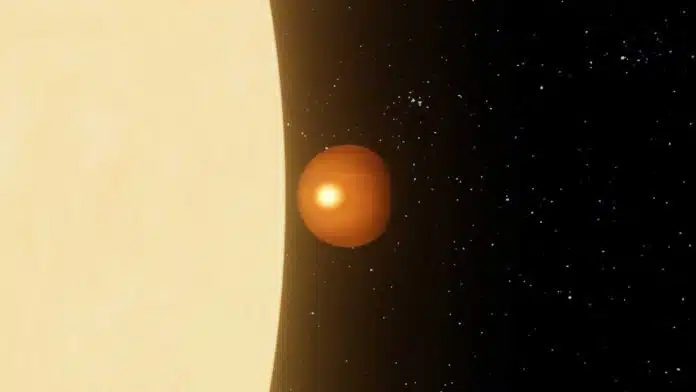
By Amit Malewar 5 Sep, 2024
Collected at: https://www.techexplorist.com/iron-winds-blowing-day-side-ultra-hot-exoplanet/89210/
The ultra-hot Jupiter WASP-76 b, the planet with extreme conditions, is a prime target for scientists to study. It has a temperature of over 2000 degrees Celsius.
In past studies, scientists have identified iron rain on its night side. They also detected the presence of barium in its upper atmosphere and the existence of a “rainbow” at the boundary between its day and night sides.
An international team of astronomers- which includes scientists from the University of Geneva and the PlanetS National Centre of Competence in Research- has now identified the presence of iron winds in the atmosphere of WASP-76 b. This discovery highlights the complex climatic dynamics of this distant world.
The planet’s dayside has a temperature of 2400 degrees Celsius. The team focused particularly on its day side by observing it at high spectral resolution in the visible light. They found a stream of iron atoms moving from the lower to the upper layers of the planet’s atmosphere.
This is the first time that scientists have made such detailed observations on the day side of this exoplanet. The observations offer significant insights into its atmospheric structure.
According to scientists, the iron winds are probably fueled by a hot spot in the atmosphere.
Scientists made this breakthrough using the ESPRESSO spectrograph, known for its precision and stability. Using this instrument, scientists have been able to acquire high-resolution planet spectra.
The light analysis allowed scientists to identify the chemical signatures of iron moving in the planet’s atmosphere. This technique, known as high-resolution emission spectroscopy.
Thanks to successful discoveries on WASP-76 b, scientists can now get a better understanding of exoplanetary climates, particularly in the case of gas giants subjected to extreme irradiation from their host star.
Using the atmospheric data, astronomers are now looking forward to building 3D models of this exoplanet’s climate. This 3d model could one-day help scientists predict similar phenomena on other distant planets.
Journal Reference:
- A. R. Costa Silva, O. D. S. Demangeon et al. ESPRESSO reveals blueshifted neutral iron emission lines on the dayside of WASP-76 b*. Astronomy & Astrophysics. DOI: 10.1051/0004-6361/202449935

Leave a Reply